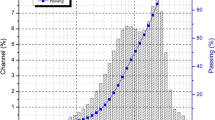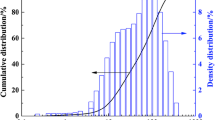Abstract
This work designed a new CaO−Al2O3−SiO2−SO3 glass for the immobilization of multiple heavy metals found in dechlorinated fly ash having high amounts of calcium and sulfur. Increasing the (CaO + SO3)/SiO2 mass ratio (M(CS/S)) from 0.28 to 0.85 was found to lower the proportions of Mn, Ni and Zn in an unstable state, while an M(CS/S) ratio of 0.51 gave the lowest proportions of unstable Cr and Pb. Decreasing the degree of polymerization of the glassy network increased the proportions of Mn, Cr, Ni, Pb and Zn in the carbonate bound state. The leaching out of metals in this state was the primary cause of degradation of Q3 structural units in the glassy network. The amount of Mn in the iron-manganese oxide bound state was increased by increasing the number of Q2 units in the silicate network. Decreasing the CaO/SiO2 mass ratio (M(C/S)) raised the proportions of Mn, Ni and Zn in the unstable state. An M(C/S) value of 0.43 lowered the proportions of unstable Cr and Pb. A principal components analysis determined that the leaching of toxic heavy metals from the glass was primarily related to the proportions of these metals in the unstable state while there were no evident correlations between leaching and the proportions in stable states.

Similar content being viewed by others
References
Chen C G, Sun C J, Gau S H, Wu C W, Chen Y L (2013). The effects of the mechanical–chemical stabilization process for municipal solid waste incinerator fly ash on the chemical reactions in cement paste. Waste Management (New York, N.Y.), 33(4): 858–865
Crum J, Maio V, Mccloy J, Scott C, Riley B, Benefiel B, Vienna J, Archibald K, Rodriguez C, Rutledge V, Zhu Z, Ryan J, Olszta M (2014). Cold crucible induction melter studies for making glass ceramic waste forms: a feasibility assessment. Journal of Nuclear Materials, 444(1–3): 481–492
Crum J V, Turo L, Riley B, Tang M, Kossoy A (2012). Multi-phase glass-ceramics as a waste form for combined fission products: alkalis, alkaline earths, lanthanides, and transition metals. Journal of the American Ceramic Society, 95(4): 1297–1303
Cyr M, Idir R, Escadeillas G (2012). Use of metakaolin to stabilize sewage sludge ash and municipal solid waste incineration fly ash in cement-based materials. Journal of Hazardous Materials, 243: 193–203
Ferraro A, Farina I, Race M, Colangelo F, Cioffi R, Fabbricino M (2019). Pre-treatments of MSWI fly-ashes: a comprehensive review to determine optimal conditions for their reuse and/or environmentally sustainable disposal. Reviews in Environmental Science and Biotechnology, 18(3): 453–471
Fuentes A, Lloréns M, Sáez J, Aguilar M I, Ortuño J F, Meseguer V F (2008). Comparative study of six different sludges by sequential speciation of heavy metals. Bioresource Technology, 99(3): 517–525
Griffiths P R (1983). Fourier transform infrared spectrometry. Science, 222(4621): 297–302
Hou H B, He X H, Zhu S J, Zhang D J (2006). The cement solidification of municipal solid waste incineration fly ash. Journal of Wuhan University of Technology (Materials Science), 21(4): 137–140
Huang T, Zhang S, Liu L (2019). Immobilization of trace heavy metals in the electrokinetics-processed municipal solid waste incineration fly ashes and its characterizations and mechanisms. Journal of Environmental Management, 232: 207–218
Krausova K, Gautron L, Karnis A, Catillon G, Borensztajn S (2016). Glass ceramics and mineral materials for the immobilization of lead and cadmium. Ceramics International, 42(7): 8779–8788
Li M, Xiang J, Hu S, Sun L S, Su S, Li P S, Sun X X (2004). Characterization of solid residues from municipal solid waste incinerator. Fuel, 83(10): 1397–1405
Ma W, Fang Y, Chen D, Chen G, Xu Y, Sheng H, Zhou Z (2017). Volatilization and leaching behavior of heavy metals in MSW incineration fly ash in a DC arc plasma furnace. Fuel, 210: 145–153
Ma W, Shi W, Shi Y, Chen D, Liu B, Chu C, Li D, Li Y, Chen G (2021). Plasma vitrification and heavy metals solidification of MSW and sewage sludge incineration fly ash. Journal of Hazardous Materials, 408: 124809
Pan Y, Wu Z, Zhou J, Zhao J, Ruan X, Liu J, Qian G (2013). Chemical characteristics and risk assessment of typical municipal solid waste incineration (MSWI) fly ash in China. Journal of Hazardous Materials, 261: 269–276
Sun T, Chen J, Lei X, Zhou C (2014). Detoxification and immobilization of chromite ore processing residue with metakaolin-based geopolymer. Journal of Environmental Chemical Engineering, 2(1): 304–309
Tessier A, Campbell P G, Bisson M (1979). Sequential extraction procedure for the speciation of particulate trace metals. Analytical Chemistry, 51(7): 844–851
Tian X, Rao F, Li C, Ge W, Lara N O, Song S, Xia L (2021). Solidification of municipal solid waste incineration fly ash and immobilization of heavy metals using waste glass in alkaline activation system. Chemosphere, 283: 131240
Wang Y, Han F, Mu J (2018). Solidification/stabilization mechanism of Pb (II), Cd (II), Mn (II) and Cr (III) in fly ash based geopolymers. Construction & Building Materials, 160: 818–827
Wey M Y, Ou W Y, Liu Z S, Tseng H H, Yang W Y, Chiang B C (2001). Pollutants in incineration flue gas. Journal of Hazardous Materials, 82(3): 247–262
Yue Y, Zhang J, Sun F, Wu S, Pan Y, Zhou J, Qian G (2019). Heavy metal leaching and distribution in glass products from the co-melting treatment of electroplating sludge and MSWI fly ash. Journal of Environmental Management, 232: 226–235
Zhang J, Liu J, Li C, Jin Y, Nie Y, Li J (2009). Comparison of the fixation effects of heavy metals by cement rotary kiln co-processing and cement based solidification/stabilization. Journal of Hazardous Materials, 165(1–3): 1179–1185
Zhang J, Zhang S, Liu B (2020a). Degradation technologies and mechanisms of dioxins in municipal solid waste incineration fly ash: A review. Journal of Cleaner Production, 250: 119507
Zhang Y, Liu S, Ouyang S, Zhang X, Zhao Z, Jia X, Du Y, Deng L, Li B (2020b). Transformation of unstable heavy metals in solid waste into stable state by the preparation of glass-ceramics. Materials Chemistry and Physics, 252: 123061
Zhao M, Cao J, Geng X, Song W, Wang Z (2020a). Structural origin of CaO−MgO−Al2O3−SiO2−Fe2O3 glass crystallization: iron-containing clusters. Journal of Non-Crystalline Solids, 547: 120295
Zhao M, Cao J, Wang Z, Li G (2019). Insight into the dual effect of Fe2O3 addition on the crystallization of CaO−MgO−Al2O3−SiO2 glass-ceramics. Journal of Non-Crystalline Solids, 513: 144–151
Zhao S, Liu B, Ding Y, Zhang J, Wen Q, Ekberg C, Zhang S (2020b). Study on glass-ceramics made from MSWI fly ash, pickling sludge and waste glass by one-step process. Journal of Cleaner Production, 271: 122674
Zhao S, Wen Q, Zhang X, Liu B, Zhang S (2021). Migration, transformation and solidification/stabilization mechanisms of heavy metals in glass-ceramics made from MSWI fly ash and pickling sludge. Ceramics International, 47(15): 21599–21609
Zhou J, Wu S, Pan Y, Zhang L, Cao Z, Zhang X, Yonemochi S, Hosono S, Wang Y, Oh K, Qian G (2015). Enrichment of heavy metals in fine particles of municipal solid waste incinerator (MSWI) fly ash and associated health risk. Waste Management (New York, N.Y.), 43: 239–246
Zou C, Cao J, Zhao M, Wang Z, Lu J (2019). Combined sodium and fluorine promote diopside continuous growth to achieve one-step crystallization in CaO−Al2O3−SiO2−Fe2O3 glass-ceramics. Journal of the European Ceramic Society, 39(15): 4979–4987
Acknowledgements
This work was financially supported by the National Natural Science Foundation of China (Nos. 52070181 and 51934006).
Author information
Authors and Affiliations
Corresponding authors
Additional information
Highlights
• A higher sulfur content reduced the curing rate of Cr in glass.
• Depolymerization increased the amounts of heavy metals in the carbonate bound state.
• Reducing the CaO/SiO2 ratio increased the proportion of stable heavy metals.
Rights and permissions
About this article
Cite this article
Chang, Y., Cao, J., Song, W. et al. Effects of sulfur on variations in the chemical speciation of heavy metals from fly ash glass. Front. Environ. Sci. Eng. 17, 128 (2023). https://doi.org/10.1007/s11783-023-1728-7
Received:
Revised:
Accepted:
Published:
DOI: https://doi.org/10.1007/s11783-023-1728-7




